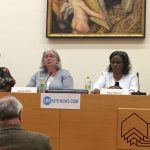“In March 2008 my youngest daughter came home from school with a form for me to sign for her to have a course of three doses of a new and much published vaccine that claimed to protect against cervical cancer” … “Lilly (nickname) had a reaction to the injection. She felt herself losing consciousness and fought the sensation but apparently went extremely pale and unresponsive for several minutes.”
Get Involved
Click here to
Extract from Renate Klein post 30 June 2009
Two weeks after receiving the “cervical cancer” vaccination known as Gardasil, 26-year-old Shannon from Melbourne remembers, “it became so difficult to breathe that I went straight to the emergency room. I was very frightened at this point. Two weeks before I had been fit and healthy, and by this stage I was limping around the house like a stroke victim, wheezing and worried I was suffocating.” Read more
Dr Renate Klein is a long term feminist academic and activist who has written extensively on the issue asking whether the HPV vaccine will prevent even one case of cancer, and warning as many people as possible that Gardasil is still unproven. Read more

Overview
FLI was one of the first organisations to highlight the risks and lack of research associated with Gardasil. The safety and efficacy of the vaccine is in question and still, our young girls and boys are being vaccinated at schools. Moreover, given the prevalence of contraceptive drugs being prescribed to teenage girls for all kinds of reasons, the masquerading effect of the contraceptive drug can conceal infertility problems among girls who have had their injections.
“It’s not that the government doesn’t know about these problems: we have been writing about girls falling very ill after the three Gardasil injections ever since the vaccinations started in April 2007. Both the former and current Health Ministers, Nicola Roxon and Tanya Plibersek, have received detailed information from injured girls and their parents. Malcolm Turnbull knows about it too.
There is a National HPV Vaccination Registry that was set up for Gardasil (even if belated only in 2008, more than 11 months after the first vaccinations). Every girl and woman who received the vaccine should now be contacted, asked about their health and offered specialists’ services if necessary.”
Additional Information
The manufacturer of Gardasil notably had its product ‘Vioxx’ withdrawn from the market due to cardiovascular problems. Doctors have been warned that Merck’s rotavirus vaccination can cause bowel obstruction in babies.
Merck recently (2013) breached Australian guidelines concerning false advertising claims for ‘Vyttorin’.
The Indian Government has discontinued and banned the use of HPV vaccination due to the notifications of multiple possible adverse events. In February 2013 the Health Ministry of Trinidad and Tobago suspended the recently implemented HPV vaccination programme in their schools.
In Japan, the Health Ministry issued a nationwide notice that the vaccination should not be recommended for girls aged 12 to 16. Read more
HPV infection in genital sites in males is largely asymptomatic and mostly transient, and will clear by itself.
However, 50% of cancer of the penis, 90% of cancer of the anus, and 25% of oral cavity cancer is attributed to HPV infections which have not cleared but persist. The incidence of anal cancer is about 1.5 per 100,000 and the incidence of cancer of the penis is 0.68 per 100,000.
Non-cancer forming anogenital warts are linked to HPV types 6 and 11, and occur in about 154 per 100,000 men and 120 per 100,000 women.
A large Australian study of men aged up to 69 showed HPV seropositive rates of 17.8%[1]. This is the estimated percentage of men who have at one time contracted HPV, but does not indicate clearance rates. Circumcision has been found to confer some protection from HPV infection. One study showed HPV was identified in 14.8% of circumcised men, and 22.3% of uncircumcised men[2].
[1] Newell AT et al, Population seroprevalence of human papillomavirus types 6, 11,16 and 18 in men women and children in Australia Clin Infect Dis. 2008 06/01;46(1537-6591;11):1647-55
[2]Auvert B et al Effect of male circumcision on the prevalence of high-risk human papillomavirus in young men. Jour Infect Dis 2009 01/01; 199(0022-1899; 1): 14-9.
- Rat ovary cellular microscopy reports are not available even under a freedom of information request.
- Hormonal contraception masks ovarian effects. Yet, the majority of women participating in safety studies were using hormonal contraception.
- New medical conditions arising more than 7 months after the first vaccination, were not considered vaccine adverse events.
- The ‘normal saline’ placebo used in very young teen safety studies contained polysorbate 80, a demonstrated ovarian toxin used in all doses injected into rats in a published study.
- Parents are not informed that there are two potential plausible biological ways HPV4 vaccine could damage young ovaries, direct toxicological and auto-immune.
- Parents’ right to informed consent on behalf of their children, is compromised by misinformation that there is no ‘plausible biological’ connection with future infertility.
- Information brochures to parents to enable informed consent do not give incidence rates of more serious potential vaccine complications.
- Parents are not informed that there is no research on ovary health and future egg-bearing capacity after vaccination.
- Parents are not informed that HPV DNA (of the vaccine type) has been found at post-mortems in the cerebral vessels and hearts of two adolescents who became ill and deceased after vaccination.
- Parents are not informed that all 16 vials of vaccine tested from 8 different countries contained HPV DNA.
Response to the fourth Brighton Collaboration (BC) journal club reviews on the article by Little DT and Ward HRG. Premature ovarian failure 3 years after menarche in a 16-year-old girl following human papillomavirus vaccination. BMJ Case Rep. 2012 Sep 30;2012
Time to Ask Questions?
By Dr. Deirdre Little
Attention has recently been drawn to the dangers that unvaccinated children face from preventable childhood diseases. In a world served by modern medicine we too easily forget the tragedies and grief once caused by polio, diphtheria and tetanus. The burden of disease and death in the case of these major childhood diseases, including whooping cough and haemophilus, vastly outweighs the incidence of adverse events arising from childhood vaccination. Lest we forget.
Complacency can be a pr oblem. But now there is another.
oblem. But now there is another.
It is concerning that some modern formulations, like the flu vaccine which caused seizures in infants, might cast a shadow over essential, more researched vaccines. Similarly, the release of the ‘fast-tracked’ human papillomavirus vaccine (to protect from four types of one sexually transmitted virus) into all our schools for all our daughters with short-circuited research – and untested effects on future fertility – should not diminish our respect for other vaccinations. Notifications coming in of young teenagers entering menopause after this vaccination do not establish cause and effect, but they do establish cause for concern.
The majority of young women in the safety trials of this vaccine against a sexually transmitted disease, were using hormonal contraception[1] during the trials. In very young teens, two trials were identified as ‘safety trials’ for licensing approval.
In one of these studies[2] more than half of the young girls (average age 12.6 years) were missing from completion of follow-up at 12 months after the first vaccination. Only 240 girls aged 10 to 15 years completed the 12 month follow-up.
In the other study[3] 492 girls were correctly vaccinated. The average age of girls in the study was 11.9 years. The placebo contained polysorbate 80[4], a known ovarian toxin[5] and other additives as well as normal saline, although referred to as a ‘normal saline’ placebo. Menstrual dysfunction reported in vaccination and placebo groups studied, was said to be comparable. Some might consider these studies were not rigorous enough to provide future ovarian safety conclusions and assurances. This problem is compounded by the lack of a microscopic evaluation (histology) of the cellular health of the rat ovary after vaccination[6].
Cycle abnormalities become invisible when girls are on the oral contraceptive pill, and unfortunately some young women are commenced on the ‘pill’ for abnormal ovary function without investigating its cause. The case report published in the British Medical Journal in 2012[7] concerned just such a young woman. Fortunately she had the good sense to ask for answers. She asked if her problem could be due to the genital wart vaccine. Unfortunately she had entered premature menopause. She was 16 years old.
The startling lack of ovarian research into a vaccine proposed for the world’s young female population means we do not have a researched answer to her question. We do know that one of the researched additives in the vaccine is toxic to rat ovaries[8]. We know it damaged ovaries at all the dosages tested on very young female rats. We do not have a dose response curve demonstrating at what dosage it becomes safe. We do know that this same additive was also present in the ‘normal saline’ placebo used as the comparator to assess vaccine safety in very young teens in the second safety study[9]. We also know a case series of young women who have prematurely entered menopause has recently been published,[10] which suggests a link between their truncated womanhood and the quadrivalent human papillomavirus vaccine.
 We also know that adverse event reporting may be thwarted by absolute assurances from the Department of Health and Ageing that there is “no biologically plausible” way this vaccine could cause infertility. A connection with premature ovarian insufficiency is a “myth”[11]. This unevidenced[12] claim contradicts the American Journal of Reproductive Immunology, whose published case series of premature ovarian failure in young women following human papillomavirus vaccination, postulates an auto-immune causology link between the vaccine and progressive ovarian damage[13].
We also know that adverse event reporting may be thwarted by absolute assurances from the Department of Health and Ageing that there is “no biologically plausible” way this vaccine could cause infertility. A connection with premature ovarian insufficiency is a “myth”[11]. This unevidenced[12] claim contradicts the American Journal of Reproductive Immunology, whose published case series of premature ovarian failure in young women following human papillomavirus vaccination, postulates an auto-immune causology link between the vaccine and progressive ovarian damage[13].
Ongoing safety assessments of this vaccine focus on a specially defined[14] category of adverse events known as Serious Adverse Events. Diminishing menstrual patterns will not signal as Serious Adverse Events. Other ongoing methods of surveillance of safety rely on knowing the normal background prevalence of a disease. Premature menopause occurring in perfectly healthy very young teens is so rare, that we don’t know the prevalence rates.
Perhaps it’s time we asked for more research on this vaccine against some genital warts and 70% of cancer of the cervix. Perhaps vaccine consent is not fully informed. The stakes are high indeed.
[1] Lu B, Kumar K et al. Efficacy and Safety of Prophylactic Vaccines against Cervical HPV Infection and Diseases among Women: A Systematic Review and Meta-analysis. BMC Infectious Diseases 2011, 11:13.
[2] Block SL, Nolan T, Sattler C et al. Comparison of the Immunogenicity and reactogenicity of a prophylactic quadrivalent human papillomavirus vaccine (types 6, 11, 16 and 18) L1 virus-like particle vaccine in male and female adolescents and young adult women. Pediatrics vol18, No.5, Nov 2006, pp2135-45.
[3] Reisinger KS, Block SL, Lazcano-Ponce E. Safety and persistent immunogenicity of quadrivalent human papillomavirus virus-like particle vaccine in pre-adolescents and adolescents: a randomized controlled trial. Pediatr Infect Dis J 2007; 26(3): 201-209.
[4] Ibid ref 3.
[5] Gajdova M, Jakubovsky J et al Delayed effects of neonatal exposure to tween 80 on female reproductive organs in rats. FdChem Toxic. Vol.31, No.3, pp183-190 1993
[6] FOI request 001-1112: Extract Study no. TT#03-703-0(CTD Module 4, volumes 1-3) summary for non-clinical report ‘Intramuscular Development toxicity and immunogenicity study in rats with postweaning evaluation’.
[7] Little DT, Ward HRG BMJ Case Reports 2012: doi: 10.1136/bcr-2012-006879
[8] Gajdova M, Jakubovsky J et al Delayed effects of neonatal exposure to tween 80 on female reproductive organs in rats. FdChem Toxic. Vol.31, No.3, pp183-190 1993.
[9] IBID footnote reference 3.
[10] Colafrancesco S, Perricone C et al Human Papillomavirus vaccine and primary ovarian failure: another facet of the autoimmune inflammatory syndrome Am JournReprodImmunol 2013 doi:10.1111/aji.12151
[11] Myths and Realities A Guide for Providers 5th Ed 2013 Aust Gov. Dept of Health and Ageing
[12] 18th World Congress of Controversies in Obstetrics Gynecology and Infertility, 0109, Vienna October 25th 2013.
[13] Ibid ref 10
[14] Serious Adverse Events defined by the Code of Federal Regulations.
Articles and further reading
Colafrancesco Serena et al. (2013). Human Papilloma Virus Vaccine & Primary Ovarian Failure: Another Facet of the Autoimmune/Inflammatory Syndrome Induced by Adjuvants. American Journal of Reproductive Immunology.doi: 10.111/aji.12151. To view Abstract of the PubMed.gov study Click here
Miranda Divine, Daily Telegraph Click here
Joan Robinson and Steven Mosher Weekly Briefing 2009 (v11) Click here
Therapeutic Goods Administrationdatabase of adverse events notified (DAEN) Click here








